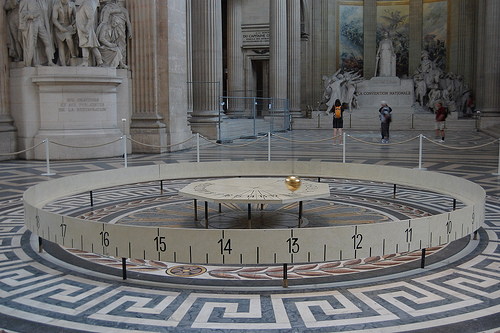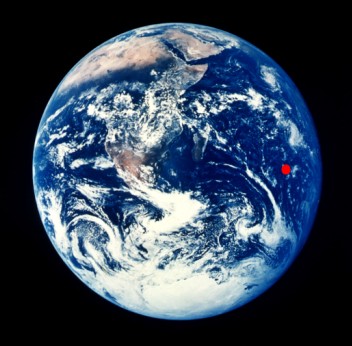Physicist: Relativity (both Galileo‘s and Einstein‘s) states that the laws of physics will work the same no matter how fast or slow you’re moving, so long as that movement is at a constant speed and in a constant direction. Galileo talked about boats, and Einstein talked about trains, but it’s all the same stuff. A point on the Earth, rather than moving in a nice straight line, is being swung around on 3 circles at the same time. As a result, physics doesn’t work quite the way it should.
One of these circles is the wobble induced by the Moon’s pull. Rather than thinking that “the Moon orbits the Earth” it helps to think that “the Moon and the Earth orbit their common center of mass”. The Earth is about 80 times more massive than the Moon, and as such, the center of the Earth-Moon system is about 1,500 km beneath the surface of the Earth (not in space between them), which is why I’m describing the effect as a “wobble”. This wobble is made apparent by the tides, which would otherwise be very mysterious (where does the force come from?).
Another circle is the Earth’s orbit around the Sun. Although they originally didn’t know why, sailors have always been aware that in addition to lunar tides there is a smaller “solar tide” that occurs every day at noon and midnight. This tide is a symptom of the Earth moving around the Sun, and it’s about 46% as strong as the lunar tide.
Finally, the most dramatic, fastest circle is the Earth’s rotation. You can tell the difference between the Sun and Moon moving around the Earth, and the Earth spinning because a stationary Earth doesn’t experience “coriolis forces”
Coriolis forces are responsible for large scale weather phenomena like hurricanes, as well as a host of much smaller, more boring effects, like Foucault pendulums.

The direction in which a Foucault Pendulum swings back and forth slowly rotates. In reality, the pendulum is trying to remain swinging in the same direction, but the Earth is turning under it.
So even before knowing the cause, it’s possible to deduce that the Earth is not stationary, because the laws of physics here are not the same as the laws we would observe on a completely stationary object.








Argh… tides. I know this has little to do with the topic at hand, but poor explanation of tides is one of my big pet peeves of physics explanations. They do not result from the wobble of the Earth as it kind of orbits the moon. Many websites (or even university professors) explain the tidal bulge on the side of the Earth opposite the Moon as resulting from this wobble. They make vague statements regarding centrifugal force, etc.
In fact, the tides result from the gradient of the Moon’s gravitational field acting on the oceans (sometimes helped out by the Sun’s gravity). They have nothing to do with the acceleration of the Earth. More precisely it is the component of the gradient that is tangent to the Earth’s surface that matters. A reduction in gravity or equivalently an acceleration of the Earth, does very little to increase the height of the ocean surface. One needs to push the water around tangent to the surface in order to build up tidal bulges. One can fairly easily see that the gradient of the moon’s gravitational force pushes the water into 2 bulges, near the moon and opposite the moon. If one could hold the Moon and Earth in place (not allowing them to orbit or smash together), you would still have tidal bulges. The tides just wouldn’t go high and low twice a day.
Otherwise I have no problems with your explanation… Sorry… I just get disproportionately bothered when tides are poorly explained, for some reason. Perhaps it is a good question for “Ask a Physicist”…
I went back and double checked the math. The way you figure out where the surface of water is going to be is to find a function for the potential energy, and set it equal to a constant. For example, under gravity alone the surface of water will be at the same height. In this case the function is an “effective potential function” (centrifugal force isn’t technically a force), but it still works. If you remove the “earth-wobble/centrifugal term” you’ll find that the water will fall below sea level on the far side of the Earth from the moon (it should be above).
Alternatively, picture the Earth with no moon. The ocean will be the same height everywhere. If you then put the moon into the sky, and nail the Earth to space so that there’s no wobble, you’ll find that the ocean will slosh toward the moon. The water will be higher on the moon side, and lower on the non-moon side.
You’d only get one tide a day, and that just ain’t right.
If you are going to answer such questions, you need to do some research and not rely on simple physics you learned in first year. Yes, of course you can introduce an effective centrifugal force, but that doesn’t mean it has any important contribution to the tides. Tides are not in fact brought about by forces but by differential forces. The comment section of a blog is not a very convenient place to make in-depth mathematical arguments, so I will simply refer you and your readers to the following webpage:
http://www.lhup.edu/~dsimanek/scenario/tides.htm
I really should have been more clear in the post; I’m using what your page calls the “equilibrium theory of tides”. Also, that page states that the centrifugal forces are constant throughout the Earth (which is not the case). If you’re bothered by the use of “effective” forces and potentials, consider that the repulsive effect of the gravitational gradient on the far side of the Earth is also an “illusionary force”. The pull of the Moon does get weaker as you move farther away (of course), but that doesn’t reverse the direction of the force.
There are a couple different approaches (mathematically), but I think this one is the most intuitive and expository.